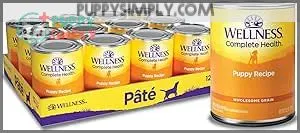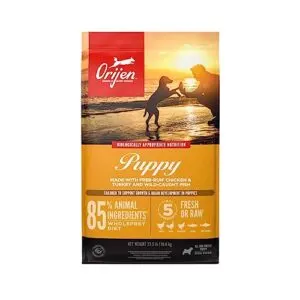This site is supported by our readers. We may earn a commission, at no cost to you, if you purchase through links.
 A proper newborn puppy feeding chart becomes your lifeline when caring for tiny pups.
A proper newborn puppy feeding chart becomes your lifeline when caring for tiny pups.
You’ll need to feed them every 2-3 hours during their first week, gradually extending to 4-hour intervals by week three.
Your puppies should gain 5-10% of their body weight daily, doubling their birth weight within seven days.
If mom isn’t available, you’ll use milk replacer through bottle feeding or tube feeding for the tiniest ones.
Watch for steady weight gain, satisfied sleeping between meals, and normal elimination patterns.
Getting the feeding schedule right from day one sets the foundation for healthy development, proper growth rates, and successful weaning phases.
Table Of Contents
- Key Takeaways
- Newborn Puppy Feeding
- Feeding Frequency Chart
- Top 4 Newborn Puppy Foods
- Milk Replacer Guidelines
- Weaning to Solid Food
- Feeding Amounts Calculator
- Common Feeding Issues
- Creating a Feeding Chart
- Supplemental Feedings Guide
- Veterinary Consultation
- Frequently Asked Questions (FAQs)
- Should I bottle feed the runt puppy?
- How do you feed a newborn puppy without a mother?
- How often should you feed a newborn puppy?
- Do you need a feeding chart for a newborn puppy?
- How much food should a newborn puppy eat?
- How much should I Feed my Puppy a day?
- How much formula should a newborn puppy eat?
- How much milk should a 5 week old puppy eat?
- How much should I feed my newborn puppy?
- How to bottle feed a 3 day old puppy?
- Conclusion
Key Takeaways
- You’ll need to feed newborn puppies every 2-3 hours during their first week, using 15ml of milk replacer per 2 ounces of body weight daily, then gradually extend feeding intervals as they grow stronger.
- You must weigh your puppies daily and track their progress—healthy pups should gain 5-10% of their body weight each day and double their birth weight within the first week.
- You can start weaning puppies to solid food around 3-4 weeks old by creating a smooth gruel mixture of puppy food and milk replacer, completing the transition by 8-10 weeks.
- You should watch for warning signs like loose stools, vomiting, weight stagnation, or excessive crying, and contact your vet immediately if feeding issues arise since newborn puppies can become dangerously dehydrated within hours.
Newborn Puppy Feeding
You’ll need to monitor your newborn puppy’s weight and feeding patterns closely during their first critical weeks of life.
Proper feeding schedules, weight tracking, and recognizing signs of healthy nursing can mean the difference between a thriving puppy and serious health complications.
Weight Monitoring Schedule
Tracking your puppy’s weight isn’t just numbers on a scale—it’s your early warning system.
Your puppy’s scale tells their survival story—every ounce matters for their future.
Proper weight monitoring catches problems before they become serious, giving you the power to act fast when your little one needs help most.
- Weigh at birth, 12 hours, 24 hours, 48 hours, 3 days, 5 days, and 7 days for ideal early detection
- Expect 5-10% daily weight gain during the first critical week of life
- Use digital scales for accurate measurements and maintain consistent growth charts
- Contact your vet immediately if weight gain stalls or decreases—veterinary intervention saves lives
Feeding Frequency Guidelines
Once you’ve got your weight tracking down, you’ll need to master feeding frequency.
Your newborn puppy feeding chart should show feedings every two hours during week one.
Age intervals matter—you can’t just wing it with demand feeding.
By week two, stretch those scheduled feedings to three-hour gaps.
Skip nighttime feedings after the first week unless your puppy’s struggling.
For large breed puppies, it’s vital to account for their unique dietary requirements for healthy development.
Signs of Proper Nursing
Healthy puppies show steady weight gain of 5-10% daily and nurse every two hours without excessive crying.
You’ll notice content, sleepy behavior after feeding sessions. Their stool consistency should be firm, not loose or watery.
Well-hydrated puppies have pink gums and warm skin.
Continuous whimpering during nursing signals potential milk insufficiency requiring immediate veterinary attention for proper newborn puppy care.
Feeding Frequency Chart
You’ll need a clear feeding schedule that changes as your puppy grows, starting with every 2 hours for newborns and gradually extending to longer intervals.
This chart removes the guesswork by showing you exactly when and how much to feed based on your puppy’s age and weight.
Age-Based Feeding Schedule
Feeding intervals change dramatically as your puppy grows from helpless newborn to playful companion.
Understanding these growth milestones helps you create the perfect puppy feeding schedule that adapts to your furry friend’s changing needs.
| Puppy Age | Feeding Frequency | Schedule Adjustments |
|---|---|---|
| 1-2 weeks | Every 2-3 hours | Round-the-clock care |
| 3-4 weeks | Every 4-6 hours | Begin weaning timeline |
| 5-8 weeks | 4 meals daily | Shift to solids |
| 8+ weeks | 3 meals daily | Adult schedule prep |
Weight-Based Feeding Amounts
Calculate your puppy’s formula needs based on their weight to prevent overfeeding risks and guarantee proper growth.
Daily weight gain depends on accurate formula calculation and adjusting portions for individual needs.
Follow these puppy feeding guidelines to determine the right puppy feeding amount for your newborn puppy feeding schedule.
| Puppy Weight | Daily Formula Amount | Per Feeding Amount |
|---|---|---|
| 2 oz | 15 mL | 3-4 mL |
| 4 oz | 30 mL | 6-8 mL |
| 6 oz | 45 mL | 9-11 mL |
| 8 oz | 60 mL | 12-15 mL |
| 10 oz | 75 mL | 15-19 mL |
The provided table outlines the daily formula amount and per feeding amount based on the puppy’s weight, ensuring proper growth and helping to prevent overfeeding.
Importance of Weight Monitoring
Weight monitoring serves as your puppy’s health dashboard.
Daily weigh-ins reveal growth patterns and catch problems before they become serious.
You’ll spot feeding issues, illness, or developmental delays through consistent tracking.
This data helps you make feeding adjustments and guarantees proper development tracking throughout those critical first weeks.
| Age | Expected Weight Gain | Health Indicators |
|---|---|---|
| Week 1 | 5-10% daily | Steady growth rate |
| Week 2 | Double birth weight | Active, alert behavior |
| Week 3 | Continued steady gain | Early detection of issues |
Weight monitoring is crucial for identifying potential health issues and ensuring your puppy is on the right track for a healthy life, with steady growth being a key indicator.
Top 4 Newborn Puppy Foods
When you’re switching your puppy from milk replacer to solid food around 3-4 weeks of age, choosing the right puppy food becomes vital for their healthy development.
You’ll want to select a high-quality formula that’s specifically designed for puppies, as these foods contain the proper protein and fat levels your growing pup needs to thrive.
1. Wellness Puppy Chicken Salmon Canned Food

When your newborn puppy graduates to solid food, Wellness Puppy Chicken Salmon delivers exceptional nutrition.
This smooth pate combines real chicken and salmon with wholesome grains, supporting brain development and immune health.
You’ll appreciate the DHA from salmon oil that boosts cognitive function.
Made in Canada without corn, wheat, or artificial preservatives, it’s gentle on sensitive stomachs.
The 12.5-ounce cans offer convenient portion control, while the savory taste keeps even picky eaters coming back for more, making it a great choice with wholesome grains.
Best For: Puppies transitioning to solid food, especially those with sensitive stomachs or picky eating habits.
- High-quality, protein-rich ingredients support growth and development.
- DHA from salmon oil enhances brain function and cognitive health.
- Gentle on digestion with no artificial preservatives or common allergens.
- Some customers received incorrect flavors in shipments.
- Contains carrageenan, which some pet owners prefer to avoid.
- Requires gradual introduction to prevent digestive discomfort.
2. ORIJEN Puppy Grain Free Dog Food

Premium nutrition often makes the difference between thriving and surviving for growing puppies.
ORIJEN Puppy Grain Free Dog Food delivers 85% fresh or raw poultry and fish ingredients, making it a powerhouse choice for your developing pup.
You’ll find chicken, turkey, chicken liver, salmon, and whole herring as the first five ingredients, which supports peak development with essential vitamins and minerals.
While it’s pricier than other options, you’re investing in your puppy’s foundation for lifelong health and wellness, which is crucial for their overall growth.
Best For: Puppy owners seeking premium, grain-free dog food with high protein content to support healthy growth and development.
- Contains 85% fresh or raw poultry and fish ingredients for complete nutrition.
- High-quality protein supports peak development and overall health.
- Freeze-dried coating enhances flavor, making it highly palatable.
- Premium price point may not fit all budgets.
- High protein content may not suit all puppies, particularly those with sensitivities.
- May cause loose stools in some dogs during dietary adjustment.
3. Blue Buffalo Puppy Small Breed Food

Your small breed puppy deserves nutrition that matches their unique needs.
Blue Buffalo’s small breed formula delivers real chicken as the first ingredient, supporting healthy muscle development during those vital early weeks.
The recipe includes DHA and ARA—the same essential fatty acids found in mother’s milk—to boost brain and eye development.
You’ll love that it contains no chicken by-products, corn, wheat, or soy.
The antioxidant-rich LifeSource Bits provide immune support, while the small kibble size fits perfectly in tiny mouths.
Puppies also benefit from moderate fat content for healthy coats.
Best For: Small breed puppy owners seeking a nutritious formula with real chicken, DHA, and no artificial fillers.
- Real chicken as the first ingredient for muscle development.
- DHA and ARA for brain and eye health.
- Small kibble size ideal for tiny mouths.
- Some puppies may not like the taste.
- Potential concerns with weight labeling accuracy.
- Not suitable for dogs with sensitivity to grains.
4. Taste of the Wild Puppy Food

This grain-free powerhouse delivers exceptional nutrition for growing puppies with roasted bison and venison as primary proteins.
You’ll appreciate the 28% protein content that supports strong bones and lean muscle development.
The formula includes omega fatty acids for brain health and proprietary probiotics for digestive support.
While it’s pricier than some alternatives, breeders consistently recommend it for healthy coat condition and energy levels.
The small kibble size works perfectly for tiny mouths, and most puppies love the roasted flavor profile.
Best For: Puppies, nursing mothers, and pregnant dogs needing high-protein, grain-free nutrition with added digestive and immune support.
- Pricier than some alternative brands.
- Some puppies may take time to adjust to the taste.
- Concerns about past heavy metal content in some formulas.
- High-quality roasted bison and venison as primary proteins.
- Supports digestion and immune health with proprietary probiotics.
- Small kibble size suitable for easy chewing.
Milk Replacer Guidelines
When you can’t provide mother’s milk, selecting the right milk replacer becomes vital for your puppy’s survival and healthy development.
You’ll need to master proper feeding techniques, positioning, and equipment selection to guarantee your newborn gets the nutrition they need to thrive.
Choosing The Right Milk Replacer
You’ll want to pick a milk replacer that closely matches mama dog’s milk composition.
Look for formula ingredients that include DHA benefits for brain development and adequate protein content.
Brand reputation matters when your puppy’s life depends on it.
Consider these factors when selecting the best puppy milk replacer:
- Vet recommendations – Ask your veterinarian which brands they trust most
- Formula ingredients – Check for DHA, omega-3 fatty acids, and essential vitamins
- Protein content – Should match natural canine milk levels (around 7-9%)
- Brand reputation – Choose established companies with proven track records
Quality newborn puppy nutrition starts with selecting the right orphaned puppy feeding formula that supports healthy growth.
Goat’s milk is often recommended due to easier digestibility for puppies.
Feeding Techniques and Positions
Hold your puppy belly-down with head slightly elevated – never on their back like human babies.
Keep the bottle at a 45-degree angle to prevent air bubbles. Feed slowly, letting them control the pace.
After every few milliliters, gently pat their back to release trapped air.
Proper puppy positioning and slow feeding techniques prevent choking and guarantee comfortable digestion.
Bottle and Nipple Selection
The right bottle and nipple make bottlefeeding your newborn puppy much easier.
Choose bottles with proper venting systems to prevent air bubbles during puppy formula feeding.
Check the nipple flow rate – milk should drip slowly, not stream out.
Glass or BPA-free plastic guarantees bottle material safety.
You can find appropriate puppy feeding supplies online.
Clean and sterilize equipment after each puppy milk replacer session for your pup’s health.
Weaning to Solid Food
You’ll start weaning your puppy from milk to solid food around 3 to 4 weeks old, creating a smooth gruel mixture of puppy food and milk replacer.
This gradual change takes about 4 to 6 weeks, and you’ll need to watch for digestive issues like diarrhea or vomiting as your puppy’s stomach adjusts to the new diet.
Transition Timing and Duration
After selecting the right milk replacer, timing your puppy’s weaning becomes your next priority.
The ideal weaning age starts between 3-4 weeks, when puppies can lap from shallow dishes.
Your gradual introduction speed matters – don’t rush this process.
Begin with liquidized puppy food mixed with milk replacer, creating smooth food texture changes over 7-9 days.
The transition length impact affects digestive health substantially.
Consider exploring options for appropriate weaning foods during this stage.
Breed-specific timelines vary slightly, but most puppies complete weaning by 8-10 weeks.
Your puppy feeding chart should track this month-long puppy food shift carefully, focusing on a successful weaning process.
Monitoring for Digestive Issues
Watching your puppy’s digestive health during weaning isn’t just important—it’s lifesaving. You’ll need to monitor stool consistency, watch for vomiting signs, and implement dehydration prevention measures.
Your puppy feeding chart should include space for tracking these key signs daily. Key warning signs to watch for:
- Loose, watery stools that persist beyond 24 hours
- Projectile vomiting or repeated regurgitation after meals
- Excessive bloating that makes your puppy’s belly tight
- Lethargy combined with loss of appetite
- Pale gums indicating possible dehydration
Make dietary adjustments immediately and schedule a vet consultation when concerns arise. You may also need to think about specific puppy treatments if issues arise.
Feeding Amounts Calculator
You’ll need to calculate the exact amount of milk replacer your puppy needs based on their current weight, since feeding too much or too little can seriously harm their development.
Use the standard formula of 15 ml of milk replacer per 2 ounces of body weight daily, then divide this total into smaller meals throughout the day based on your puppy’s age.
Calculating Daily Feeding Amounts
Getting your newborn puppy feeding chart right starts with accurate Weight-Based Calculation. You’ll need 15ml of formula per 2 ounces of body weight daily.
A 4-ounce puppy requires 2 tablespoons every 3-4 hours. Individual Variation matters—some pups need slightly more.
To facilitate proper development, it’s vital to use puppy food formulated with balanced nutrients. Consider Calorie Requirements and Formula Concentration when measuring.
Here’s your reference:
| Puppy Weight | Daily Formula Amount |
|---|---|
| 2 oz | 15 ml (1 tablespoon) |
| 4 oz | 30 ml (2 tablespoons) |
| 6 oz | 45 ml (3 tablespoons) |
| 8 oz | 60 ml (4 tablespoons) |
| 10 oz | 75 ml (5 tablespoons) |
Adjusting Feeding Amounts Based on Weight
Puppies grow fast, so you’ll need to weigh them weekly and adjust portions accordingly.
Your newborn puppy feeding chart should reflect each pup’s individual puppy needs since some gain weight faster than others.
Monitor stool consistency as you increase feeding amounts – loose stools mean you’re overdoing it.
When puppy weight doubles, increase formula by 25% for proper weight gain goals.
For large breed puppies, it’s vital to account for their growth sensitivity during feeding, considering their unique growth requirements and feeding needs.
Importance of Accurate Feeding Measurements
Accurate measurements aren’t just recommended—they’re lifesavers for newborn puppies.
Your puppy feeding amounts must be precise to prevent overfeeding and avoiding underfeeding, both dangerous extremes.
Using a newborn puppy feeding chart with formula precision guarantees consistent intake for proper growth monitoring.
Remember, even small measurement errors can lead to dehydration or malnutrition, making weight monitoring and feeding measurements absolutely critical.
Common Feeding Issues
Even when you’re following feeding guidelines perfectly, your newborn puppy might still experience digestive problems like diarrhea, vomiting, or regurgitation.
You’ll need to recognize these common feeding issues quickly and know how to respond, since newborn puppies can become dangerously dehydrated within hours.
Diarrhea and Vomiting
Your calculated feeding amounts won’t matter if digestive issues strike. Overfeeding ranks as the top cause of puppy feeding problems, leading to dangerous bloating and loose stools.
Three warning signs to watch:
- Puppy stool consistency changes from firm to watery
- Puppy dehydration shows through dry gums and lethargy
- Puppy bloating creates a distended, hard belly
Prevention beats treatment—stick to measured portions and monitor hydration closely.
Regurgitation and Aspiration
Puppy regurgitation happens when milk comes back up through the mouth or nose during feeding.
This creates serious puppy feeding concerns because liquid can enter the lungs, causing aspiration pneumonia.
Prevention methods include feeding at proper angles and slower rates.
Emergency response requires immediate veterinary intervention if you notice breathing difficulties.
Long-term effects can be life-threatening without prompt treatment.
Dehydration Signs and Prevention
Recognizing dehydration early can save your puppy’s life.
Check for sticky gums, sunken eyes, and skin that doesn’t snap back when pinched.
Proper fluid administration and electrolyte balance are essential.
Follow your puppy feeding chart closely and guarantee adequate milk intake.
Preventative measures include consistent feeding schedules and monitoring weight gain.
Seek immediate veterinary intervention if dehydration signs appear, as proper fluid administration and early recognition can be crucial.
Creating a Feeding Chart
You’ll need a detailed feeding chart to track your puppy’s weight, feeding times, and health progress effectively.
This chart becomes your roadmap for ensuring proper nutrition, helping you spot potential issues early and adjust feeding amounts as your puppy grows.
Tracking Weight and Feeding Schedules
Building your newborn puppy feeding chart requires precise record-keeping.
You’ll track each puppy’s weight daily and adjust feeding intervals based on their growth.
Create a simple chart that shows Weight Gain Goals alongside actual progress.
Document feeding frequency changes as puppies mature, allowing for Schedule Flexibility when Individual Puppy Needs vary from standard guidelines.
| Tracking Element | Frequency |
|---|---|
| Weight Monitoring | Daily for first 4 weeks |
| Feeding Interval Adjustments | Weekly based on age/weight |
| Schedule Documentation | After each feeding session |
To ensure the health and development of your puppies, it is crucial to monitor their progress closely, making adjustments as necessary to support their Individual Puppy Needs and overall Weight Monitoring.
Monitoring Stool Consistency and Color
Beyond tracking your puppy’s weight, their stool tells an important story about their health. Healthy newborn stools should be orange-colored and soft but not liquid.
Changes in stool consistency or unusual colors signal feeding problems or health issues requiring immediate attention. Knowing what’s normal can help you identify when your puppy needs veterinary attention, so it’s important to understand healthy puppy poop.
| Stool Color | Meaning | Action Needed |
|---|---|---|
| Orange/Brown | Normal, healthy digestion | Continue current feeding |
| Green | Bacterial infection possible | Contact vet immediately |
| Black/Red | Blood present, serious issue | Emergency vet visit |
Monitor daily using your puppy feeding chart to track patterns and catch problems early.
Adjusting Feeding Amounts and Frequency
Successful puppy feeding chart management requires constant tweaking based on your pup’s growth rate and individual needs.
Monitor stool consistency daily and adjust portions when you notice changes.
Regular vet consultations help fine-tune your puppy feeding schedule, ensuring ideal hydration levels and preventing digestive issues.
| Adjustment Factor | When to Increase | When to Decrease |
|---|---|---|
| Weight Gain | Less than 5% daily | More than 10% daily |
| Stool Quality | Firm, normal color | Loose or watery |
| Activity Level | High energy, active | Lethargic, bloated |
Supplemental Feedings Guide
Sometimes mother dogs can’t produce enough milk for their entire litter, and you’ll need to step in with supplemental feedings to keep the puppies healthy.
You’ll learn how to recognize when puppies need extra nutrition, calculate the right amounts of milk replacer, and establish feeding schedules that work alongside natural nursing.
When to Supplement Maternal Milk
When your mama dog can’t keep up with her babies’ demands, you’ll need to step in.
Watch for puppies crying constantly, weight stagnation, or competition in large litters.
Maternal health issues like mastitis also signal trouble.
If orphaned puppies arrive or you notice inadequate supply, immediate bottle feeding with puppy milk replacer becomes essential for survival.
Calculating Supplemental Feeding Amounts
You’ll need to calculate each puppy’s specific needs based on their current weight. The standard formula is 15 mL of puppy milk replacer per 2 ounces of body weight daily. However, individual variation means some puppies need more or less.
Your newborn puppy feeding chart should track weight gain patterns to make proper formula adjustments.
- Daily weigh-ins: Record each puppy’s weight at the same time daily to track consistent growth patterns
- Calculate fresh amounts: Multiply current weight by feeding ratio, then divide by number of daily meals
- Adjust for growth: Increase feeding amounts as puppies gain weight, following your puppy feeding chart week by week
- Monitor success indicators: Watch stool consistency, energy levels, and steady weight gain to confirm adequate nutrition
Frequency of Supplemental Feedings
You’ll need to adjust feeding intervals based on your puppy’s specific situation.
Orphaned puppies require supplemental feedings every 3-4 hours when insufficient milk from maternal sources occurs.
These feedings must be evenly spaced throughout the day and night.
Your newborn puppy feeding chart should include 1-6 supplemental bottle feeding sessions daily, depending on how much puppy milk replacer support they need.
Veterinary Consultation
You can’t navigate newborn puppy feeding alone, and your vet becomes your most important partner in keeping these tiny lives healthy.
Regular check-ups help you spot feeding problems early, adjust feeding amounts correctly, and recognize when something’s wrong before it becomes serious, which is crucial for the health of the puppies and highlights the importance of regular check-ups.
Importance of Regular Veterinary Check-Ups
Regular veterinary care acts as your safety net during those critical first weeks.
Your vet establishes vaccination schedules, monitors for congenital issues, and certifies proper nutritional needs are met.
Early detection of problems through professional puppy health assessments can literally save lives.
Don’t skip these appointments—your newborn puppy feeding chart means nothing without expert oversight and parasite prevention guidance.
Seeking Professional Advice for Feeding Concerns
Don’t hesitate to contact your vet when puppy feeding concerns arise. Professional veterinary advice can prevent serious complications and save your puppy’s life.
Contact veterinary care immediately for these puppy feeding issues:
- Weight stagnation lasting more than 24 hours
- Persistent vomiting after multiple feedings
- Severe diarrhea causing dehydration
- Refusal to feed for several hours
Online vet consultation services offer convenient access when feeding complications occur.
Signs of Overfeeding and Underfeeding
Overfeeding shows up as loose stool consistency, vomiting, and bloated bellies.
Your puppy feeding chart should track steady weight gain – not rapid spikes.
Underfeeding creates the opposite problem: poor growth stunting, constant crying, and dehydration.
Watch puppy behavior closely. Healthy pups sleep peacefully between meals, while underfed ones stay restless and whiny.
Your puppy’s overall health, including steady weight gain, is crucial for development.
Frequently Asked Questions (FAQs)
Should I bottle feed the runt puppy?
You should bottle feed the runt if it’s struggling to compete with littermates or losing weight.
Monitor its daily weight gain closely—healthy puppies gain 5-10% daily and double their birth weight within the first week.
How do you feed a newborn puppy without a mother?
You’ll need puppy milk replacer and a nursing bottle.
Feed every 2-3 hours, holding the puppy stomach-down.
Use 15ml per 2oz body weight daily.
Burp gently after feeding and stimulate elimination with warm cotton.
How often should you feed a newborn puppy?
Many believe puppies eat constantly, but that’s not true.
You’ll feed newborn puppies every two hours for the first week, then gradually extend to three-hour intervals by week two as they grow stronger.
Do you need a feeding chart for a newborn puppy?
Yes, you’ll want a feeding chart to track your newborn puppy’s schedule and amounts.
It helps guarantee proper nutrition, weight gain, and prevents overfeeding or underfeeding during those critical first weeks.
How much food should a newborn puppy eat?
Don’t worry about exact measurements being complicated.
Your newborn puppy needs 15 mL of milk replacer per 2 ounces of body weight daily, divided into frequent feedings every 2-3 hours around the clock.
How much should I Feed my Puppy a day?
Daily feeding amounts depend on your puppy’s age and weight. Newborns need 15ml milk replacer per 2oz body weight daily, divided into frequent meals every 2-3 hours throughout the day.
How much formula should a newborn puppy eat?
While adult dogs eat twice daily, newborn puppies need constant nourishment.
Feed your puppy 15 milliliters of formula per 2 ounces of body weight daily, divided into small meals every 2-3 hours around the clock.
How much milk should a 5 week old puppy eat?
A 5-week-old puppy needs about 4 meals daily, shifting from milk replacer to solid puppy food.
You’ll feed every 5-6 hours, gradually reducing liquid as they adapt to eating more solid food portions.
How much should I feed my newborn puppy?
Getting the amount just right can feel overwhelming, but it’s simpler than you’d think.
Feed your newborn puppy 15 mL of milk replacer per 2 ounces of body weight daily, divided into frequent meals.
How to bottle feed a 3 day old puppy?
Hold your 3-day-old puppy stomach-down at a 45-degree angle.
Use puppy milk replacer at skin temperature through a slow-flow bottle.
Feed every 2-3 hours, giving 15ml per 2oz body weight daily.
Conclusion
Surprisingly, what seems like rocket science actually comes down to basic math and consistent observation.
Your newborn puppy feeding chart doesn’t need complexity—just dedication to regular feedings, accurate weight tracking, and quick adjustments when needed.
You’ve got the tools to recognize hunger cues, calculate proper amounts, and spot feeding issues before they escalate.
Trust your instincts, follow the schedule, and remember that successful puppy feeding is about consistency, not perfection.
You’re equipped to handle this, with the ability to make quick adjustments when needed.
- https://vcahospitals.com/know-your-pet/puppy-raising
- https://www.akc.org/expert-advice/dog-breeding/raising-newborn-puppies/
- https://resources.bestfriends.org/article/caring-orphaned-newborn-puppies-basic-care-feeding-and-disease-prevention
- https://www.magonlinelibrary.com/doi/abs/10.12968/vetn.2016.7.6.352?journalCode=vetn
- https://vcacanada.com/know-your-pet/feeding-orphaned-puppies


















